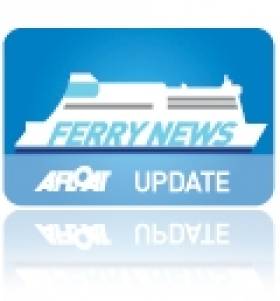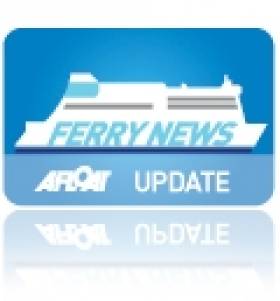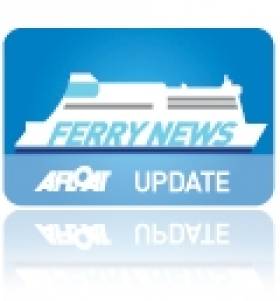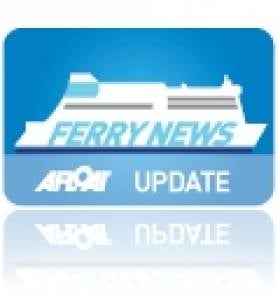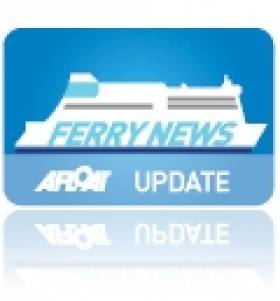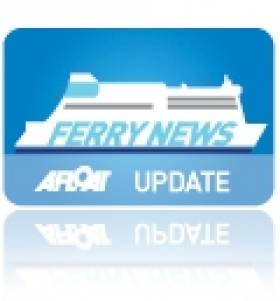Displaying items by tag: IOM Steam Packet Co
#TTracesFerry- The UK Bank Holiday last Monday, was the first day that the Isle of Man Steam Packet Company accepted bookings for the TT Races (in 2015) and where a substantial increase in traffic was booked compared with last year.
According to the ferry operator, almost 7,000 passengers booked to travel in just 10 hours. The timeframe involved reservations been made from 8.30am and by close of business at 6.30pm, more than 2,500 bookings had been completed.
This level of bookings for the 2015 event equated to an increase of more than 41% compared with the first day of TT bookings in 2013. This year's TT Races are already underway as the fortnight event continues to 6 June.
Initial figures show 6,957 passengers booked for the 2015 TT when reservations opened, compared with 4,314 last year. The number of motorcycles booked increased to 3,452, from 1,966, and the number of other vehicles, including cars and vans, increased from 647 in 2013 to 935 this year.
Almost 1,500 reservations were made by phone or in person, with more than 1,000 made through www.steam-packet.com
Next Saturday, as part of Afloat.ie's dedicated Ferry News section, a new Ferry Profile and interview feature will focus on Captain Allan Albiston, master of the Isle of Man Steam Packet Co's ro-pax Ben-My-Chree (1998/12,747grt).
The vessel recently returned to service fresh from a £1.6m overhaul and refurbishment of passenger facilities and crew accommodation.
Her Manx name when translated means 'Girl of My Heart' has been the workhorse for the company for more than 15 years. She operates the main link to the mainland between Douglas and Heysham.
In addition Ben-My-Chree occasionally operates on the seasonal-only operated Dublin-Douglas route and during the winter months to Birkenhead.
#FerryOverhaul- The ro-pax ferry Ben-my-Chree which is undergoing a £1.6m overhaul and refurbishment is according to the Isle of Man Steam Packet on schedule to re-enter service next week.
The 12,500 tonne ship, which as previously reported on Afloat.ie, went to Cammel Laird, Birkenhead for dry-docking last month is to return on the Douglas-Heysham route next Wednesday.
For the last 16 years the Dutch built ferry has served the principle Manx link to England and this biennial overhaul refurbishment of passenger and crew areas also involves technical examination.
Marine interior refurbishment specialists Trimline, based in Southampton have refitted and revitalised a number of areas on board. This is reflected in public areas with a new layout in the Café bar, incorporating additional banquette seating, tables, tub chairs and walkway layout, plus new carpets and Amtico planks.
In the main lounge, new carpets and flooring have been laid, seats have been re-upholstered, artwork and signage updated, table tops replaced and new LED lighting has been installed.
Ben-my-Chree is scheduled to return to service in advance the busy TT Races. In her place on the Manx capital-Lancashire route, is the fast-craft passenger ferry Manannan. While freight duties, are been carried out by the 65-unit Arrow which the Steam Packet secured on a long-term charter.
Chief Executive Mark Woodward said: 'Ben-my-Chree undergoes a technical overhaul every two years and this year we have taken the opportunity to also enhance facilities for both passengers and crew.
'We have responded to feedback in this refurbishment, to make the public areas of the vessel even more comfortable as well as cleaner and brighter. It has been a significant investment for the company, but one which I hope will further improve the on-board experience.'
Isle of Man Steam Packet Reopen Irish Routes for Easter Weekend
#ManxEasterSailings – Isle of Man sailings to and from Douglas to Dublin and Belfast ports, start this week in advance and during the Easter Bank Holiday Weekend, writes Jehan Ashmore.
Firstly Douglas-Dublin Port sailings set off tomorrow early morning from the Manx capital served by fast-craft Manannan which returns back to the Isle of Man for a lunchtime arrival.
Manannan is also to take the honour in re-opening Douglas-Belfast sailings on Friday, 18 April with a departure at 15.00hrs from the Isle of Man and with the fast-craft ferry arriving in Belfast at 17.45hrs. She departs Belfast that same evening at 18.45 and is to complete the day-round trip with an arrival to Douglas scheduled for 21.30hrs.
For further information of sailings on both routes during the Easter Weekend consult the Isle of Man Steam Packet sailing schedule HERE and by checking the latest information sailing updates from this LINK.
In addition the Steam Packet operate other services linking the Isle of Man to the UK on the following routes, Douglas-Heysham and Douglas-Liverpool.
Stars & Stripes Flown From Fast-Ferry as IOM Steam Packet Mark Retirement of US Navy Captain
#ShipStarStripes – The Isle of Man Steam Packet Company fast-ferry Manannan which resumed seasonal Liverpool-Douglas sailings recently, flew a United States of America flag to mark the retirement of Captain Thomas Shaw, who commanded the vessel during her time with the US Navy.
Captain Shaw officially retires in June after 27 years' military service, and the Steam Packet Company agreed to recognise his service with Manannan – known as USS Joint Venture during his command – after being approached by Commander Robert Stover.
Commander Stover, Director of Engineering with the Afloat Training Group in San Diego, said: 'The significance for Captain Shaw will be that the Steam Packet Company graciously took the effort to recognise his transition from the military service.
As previously reported by Afloat.ie in 2011, the 5,029grt craft was used for various trials and demonstrations and in which saw service in the Persian Gulf in support of 'Operation Iraqi Freedom' and in 2003 'Operation Enduring Freedom' in the Horn of Africa.
#Ferry&Freight -The Isle of Man Steam Packet Company's latest investment in freight services will begin operating on 28 April, the new service Afloat.ie previously reported on last Autumn, will see ro-ro vessel Arrow introduced.
The 84 trailer Arrow is on a long-term charter from Seatruck Ferries and she will cover for ro-pax Ben-my-Chree, while she undergoes her scheduled biennial overhaul as reported earlier today.
The overhaul of the 630 passenger vessel, which will include some of the passenger lounges being refurbished and additional seats being added to the Cafe Bar, is expected to take around three weeks.
During this time, the Arrow will provide freight services between Douglas and Heysham and fast-ferry Manannan will cover passenger services.
While Ben-my-Chree is in dry dock, Manannan will provide some passenger services between Douglas and Heysham, including the Saturday mornings of May 3, 10 and 17 respectively.
This will impact on normal Saturday morning services to Liverpool, but to ensure people who want to enjoy a weekend day trip to the city are able to, the Steam Packet Company is providing a series of special day excursions on each of these Saturdays.
The day excursions will allow people to sail to Heysham, travel to Liverpool by coach and return to the Island the same day from Liverpool. There will also be the option of spending the Saturday night in Liverpool and returning to the Island on the Sunday evening. Prices start from £39 return for adults.
Arrow will also supplement Ben-my-Chree and Manannan during the TT period and potentially at other times of peak demand to allow extra capacity for passengers. For further details visit www.steam-packet.com
#FerryRepairs – The Isle of Man Steam Packet Company has been informed by Italian shipbuilders, Fincantieri, manufacturers of the fin stabiliser which was damaged and removed in January, will be completed and ready for re-fitting for ro-pax Ben-my-Chree in June.
The 12,500 tonnes passenger and freight vessel sustained damage to one of its two stabilising fins during heavy weather at the start of the year. Following an inspection in late January, a decision was made to remove the affected fin and return Ben-my-Chree to service until the repaired unit was ready to be re-fitted.
The Steam Packet Company can confirm work to install the repaired fin will take place in a quiet period from 19-21 June and a revised sailing schedule will operate during this period.
The Manx ferry operator is contacting any passengers affected on these dates in the coming weeks and the fast-craft Manannan and freight ferry Arrow will provide sailings to Heysham and Liverpool.
Ben-my-Chree has effective stabilising efficiency with only one fin operational, and there is no impact on the vessel's ability to sail, nor to berth, safely.
Isle of Man Steam Packet Joins Manx Interests Over Concerns of Wind-Farm Development to UK Planning Inspectorate
#FerryWindFarm – The Isle of Man Steam Packet website has posted a piece about the proposed extension to the Walney Offshore Wind Farm following a public hearing of the UK Planning Inspectorate as previously reported on Afloat.ie.
Also attending the hearing were the Isle of Man Government, Travelwatch Isle of Man, the Island's Chamber of Commerce and a variety of other bodies with interests in shipping who have outlined concerns about the proposal.
The plans for development off the Cumbrian coast submitted by Dong Energy, were considered during a hearing held last week at the Villa Marina in Douglas, and the cumulative impact of proposed offshore wind farm developments in the Irish Sea was also discussed.
Air navigation matters were explored in the morning session as wind farms impact on radar cover for aircraft. The impact on sea navigation and safety, as well as the social and economic implications for the Island, were discussed in the afternoon session.
Steam Packet Company Commercial Director John Watt explained there could be a serious economic impact on the Isle of Man.
The piece posted on the ferry company website also shows a chart of the area outlining proposed extended wind-farms and an illustration comparing the scale in size between the Steam-Packet's ro-pax Ben-My-Chree, the wind-turbines and Blackpool Tower.
#WindFarm –According to Isle of Man.com, inspectors are returning to the UK having plenty to consider following a public hearing about a proposed wind-farm extension.
Yesterday, the three-strong team heard evidence about the Walney Wind Farm extension planned by Dong Energy.The plans would see more turbines – 200 metres tall, dwarfing Blackpoool Tower - in the Irish Sea to the Northeast of the Isle of Man.
Representatives from the airport expressed concerns about possible interference with radar, while the Steam Packet Company said a proliferation of wind turbines could be bad news for passengers. For more click this link.
Peel Castle Wins Cover Shot for Manx Ferry Brochure
#BrochureAppeal – Peel Castle, a magnificent fortress set on St Patrick's Isle and overlooking Peel Marina is the winning front cover shot of the 2014 Isle of Man Steam Packet Company brochure.
Robert Robinson of St. Helens took the winning entry and as previously reported on Afloat.ie, the company launched last year the cover brochure competition through facebook. More than 500 photographs were entered from as far afield as Australia, Canada, USA and Switzerland.
The operator chose from photographs that required scenic settings of the beautiful island or their ships, Ben-my-Chree and Manannan, which as reported is having an annual refit prior to starting seasonal sailings next month linking Liverpool and Douglas.
The Isle of Steam Packet Company which is also simply referred to as the 'steam-packet' is claimed to be the oldest continually operating passenger shipping company in the world, having begun operations in 1830.
Ellan Vannin Line to Consider Next Step
#ManxLink – Manx Radio reports that the head of a would-be competitor to the Isle of Man Steam Packet Company says he hasn't given up after being denied access to their linkspan in Douglas Harbour.
Captain Kurt Buchholz, chief executive of Ellan Vannin Line, says the government's decision is a blow but the company is determined to set up a rival ferry service.
He's now considering the company's next steps as it tries to challenge the linkspan user agreement with the Steam Packet.


























